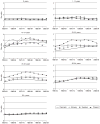Men: good health and high mortality. Sex differences in health and aging
- PMID: 18431075
- PMCID: PMC3629373
- DOI: 10.1007/BF03324754
Men: good health and high mortality. Sex differences in health and aging
Abstract
This review examines sex differences in health and survival, with a focus on the Nordic countries. There is a remarkable discrepancy between the health and survival of the sexes: men are physically stronger and have fewer disabilities, but have substantially higher mortality at all ages compared with women: the so-called male-female health-survival paradox. A number of proposed explanations for this paradox are rooted in biological, social, and psychological interpretations. It is likely to be due to multiple causes that include fundamental biological differences between the sexes such as genetic factors, immune system responses, hormones, and disease patterns. Behavioral differences such as risk-taking and reluctance to seek and comply with medical treatment may also play a role. Another consideration is that part of the difference may be due to methodological challenges, such as selective non-participation and under-reporting of health problems, and delayed seeking of treatment by men. The Nordic countries provide a unique opportunity for such studies, as they have good-quality data in their national health registers, which cover the whole population, and a long tradition of high participation rates in surveys.
Figures



References
-
- Olsen KM, Dahl S-A. Health differences between European countries. Soc Sci Med. 2007;64:1665–78. - PubMed
-
- Preston SH. Studies in population. New York: Academic Press; 1976. Mortality patterns in national populations: with special reference to recorded causes of death.
-
- Nathanson CA. Illness and the feminine role: a theoretical review. Soc Sci Med. 1975;9:57–62. - PubMed
-
- Wingard DL. The sex differential in morbidity, mortality, and lifestyle. Annu Rev Public Health. 1984;5:433–58. - PubMed
Publication types
MeSH terms
Grants and funding
LinkOut - more resources
Full Text Sources
Medical
